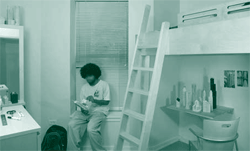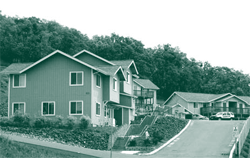June 2008
In this Issue
Black Colleges and Universities Lend a Helping Hand
Learning To House the Homeless
Researching HUD's Housing Programs
What We Know About LIHTCs
In the next issue of ResearchWorks
Learning To House the Homeless
Created in 1988, the Fannie Mae Foundation's Maxwell Awards recognize the outstanding work of nonprofit organizations that develop and maintain affordable housing in urban, metropolitan, and rural communities nationwide. The 2007 award winners were selected for their excellence in creating and managing supportive housing for homeless individuals and families. Four nonprofits each received the top prize of $75,000: The Connection Fund in New Haven, Connecticut; the Downtown Emergency Service Center (DESC) in Seattle, Washington; La Casa Norte in Chicago, Illinois; and Umpqua Community Action Network in Roseburg, Oregon. An independent advisory committee chose these projects as the best examples of supportive housing for four homeless populations: veterans, individuals, youth, and families. The award winners are attacking homelessness with innovation, commitment, and persistence. Their challenges, successes, and strengths, from which other communities can learn a great deal, are highlighted below.
New Haven, Connecticut
The Connection Fund project winner, Legion Woods, offers 20 units of permanent suppportive housing to the chronically homeless, giving priority to veterans. Of the 20 original residents, all but one remain in their apartments after a year and a half — a strong indicator of success. Legion Woods employs the Housing First model, with no requirement that residents use supportive services. According to Jim O'Rourke, development director of the Connection Fund, the supportive services accessible through the Department of Veterans Affairs (for 13 participating veterans) and Columbus House play an important role in sustaining residents in their homes. The nonprofit sees its relationship with these two agencies as illustrative of one of the program's strengths — it has backing and assistance from numerous organizations and government agencies. Such collaboration was crucial to the development of this project, which required several years of planning and persistence to acquire the site and coordinate resources. Collaboration was also valuable in addressing public resistance to the project, which stemmed from the stigma attached to homelessness and concerns about the planned concentration of human services.
The Connection Fund team puts significant effort into neighborhood outreach, which is also touted as one of the program's strengths. The housing stands on a formerly blighted, abandoned property that now adds value to the neighborhood and to the city's tax roll. Residents are encouraged to engage in neighborhood activities like cookouts, gardening, and the local Block Watch program.
Seattle, Washington
In 2005, DESC opened the doors of a new facility, 1811 Eastlake, to 75 homeless men and women described as chronic public inebriates. Arguably the most challenging of groups, this fragile population puts significant stress on publicly funded services provided by police, jails, courts, alcohol detox centers, 911 systems, ambulance transports, and hospital emergency rooms. The residents of 1811 Eastlake were invited to move into the facility because they were identified as those most frequently requiring these services. Optional supportive services available to residents include 24-hour staffing, state licensed mental health care and chemical dependency treatment, a full-time registered nurse, and a veterans' support group.
The 1811 Eastlake project has attracted considerable media attention, with one of the most common questions being whether this model can actually work with chronic alcoholics. Within the first year, as its staff came to know the residents, DESC could see that its model was working. Because of the need to replicate success in resolving homelessness, however, DESC knew that other communities would want to know whether their model would reduce chronic alcoholics' use of expensive public services. Although researchers at the University of Washington are conducting a 3-year program evaluation, DESC can already point to a $2.5 million decline in crisis and emergency healthcare costs to the community after the first year of operation. Medical expenses for the residents were down 41 percent, county jail stays dropped by 45 percent, stays in detox centers fell by 87 percent, and the residents no longer required emergency shelter stays. Residents of 1811 Eastlake have also voluntarily cut their alcohol consumption in half.
Chicago, Illinois

La Casa Norte's Solid Ground Supportive Housing Program, located in the Humboldt Park neighborhood, provides housing and onsite services to homeless male youth aged 16 – 21. Supportive services are designed to help residents become independent by providing educational, employment, and life skills development. This award winner serves mostly African American and Latino youth, and offers a safe and healthy environment in which residents are able to envision alternatives to violence, maladjustment, and mental health difficulties.
As do the other winners, Solid Ground emphasizes its immersion in the fabric of the community and the collaborative efforts of numerous partners in developing the facility and program. Sol Flores, the executive director of La Casa Norte, reports that development took more than 2½ years and humorously refers to the challenge of achieving layered or "lasagna funding," in which all of the timelines, funding cycles, matching requirements, and goals of various resources had to be coordinated and in place to meet multiple deadlines. Partners included HUD, the city of Chicago's Department of Housing, the Illinois Department of Commerce and Economic Opportunity, the Federal Home Loan Bank, the Illinois Housing Development Authority, private foundations and individuals, and the Humboldt Park community.
Roseburg, Oregon

The Umpqua Community Action Network (UCAN) developed Grandview Homes, located in a rural area of Oregon where services for the homeless are scarce. The project has 10 units for homeless families that have an adult member with a psychiatric disability. Residents have access to both on- and offsite supportive services. The facility has been open for over two years, and only two families have left — one was evicted and one transitioned to market-rate housing. This retention rate is one of the program's measures of success, because stabilizing these special-need homeless families is the project's ultimate intent.
UCAN credits its success to making the needs of its residents the focal point for facility and program design. For example, the children's playground is in direct sight of all units. Windows in the development do not face each other, ensuring residents' privacy. A quiet room gives residents a safe place to relax and relieve stress, thus reducing the need for emergency interventions. Full fencing and well-lighted grounds address residents' security concerns. A meeting room that serves as the site of many supportive services features an adjacent tot lot. The colors are bright and uplifting, and the units feature built-ins, requiring less home furnishings. Grandview is also an energy-efficient and comfortable green development. Rents are based on 30 percent of resident household incomes, and all utilities are paid by the property.
Each Maxwell Award winner uses the Housing First model to serve a unique segment of the homeless population in creative ways that will be informative to groups in other localities working to eliminate homelessness. Further details and contact information are available at www.endlongtermhomelessness.org/2007_maxwell_awards/
2007_maxwell_awards_ finalists.aspx.

